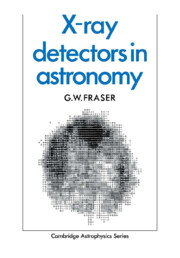Book contents
- Frontmatter
- Contents
- Preface
- Acknowledgements
- Units and constants
- 1 Observational techniques in X-ray astronomy
- 2 Proportional counters
- 3 Microchannel plates
- 4 Semiconductor detectors
- 5 Scintillators, phosphors and NEADs
- 6 Single photon calorimeters
- Appendix A Observational X-ray astronomy: a bibliography
- Appendix B X-ray data analysis techniques
- References
- Index
- Frontmatter
- Contents
- Preface
- Acknowledgements
- Units and constants
- 1 Observational techniques in X-ray astronomy
- 2 Proportional counters
- 3 Microchannel plates
- 4 Semiconductor detectors
- 5 Scintillators, phosphors and NEADs
- 6 Single photon calorimeters
- Appendix A Observational X-ray astronomy: a bibliography
- Appendix B X-ray data analysis techniques
- References
- Index
Summary
The first cosmic X-ray source was discovered in June, 1962, during the flight of an Aerobee sounding rocket from the White Sands missile range in New Mexico (Giacconi et al, 1962). As the rocket spun about its axis, three small gas-filled detectors scanned across a powerful source of low-energy X-rays in the constellation of Scorpius, in the southern sky. Even though the position of the source (later designated Sco X-l) could only be determined to within an area of some hundred square degrees, cosmic X-ray astronomy had begun.
As usually recounted, the story of Sco X-l and the birth of X-ray astronomy bears a not inconsiderable resemblance to the story of X-rays themselves. The element of serendipity seems all-important in both discoveries. Wilhelm Roentgen, in 1896, had been intent on measuring the aether waves emitted by a low-pressure gas discharge tube when, by chance, he discovered his new and penetrating radiation. In 1962, the expressed aim of the American Science and Engineering (AS&E)-MIT research group led by Riccardo Giacconi was to detect the X-ray emission, not of distant stars, but from the moon.
Detailed consideration undermines this neat parallel. There is in fact a clear evolutionary line linking X-ray astronomy and the pioneering solar studies carried out in the USA by the Naval Research Laboratory (NRL) group under Herbert Friedman. Friedman's solar X-ray observations had begun with the flight of a captured German V2 rocket in September, 1949.
- Type
- Chapter
- Information
- X-ray Detectors in Astronomy , pp. vii - ixPublisher: Cambridge University PressPrint publication year: 1989

